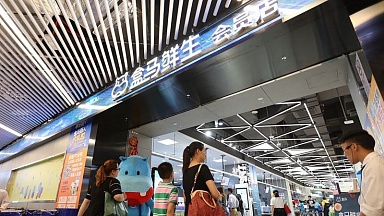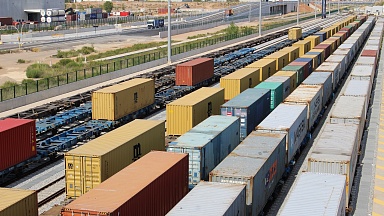Over the past few years, Germany’s rail freight market has been high on the political agenda. At a time when the climate crisis is becoming harder to ignore, and traffic volumes are steadily increasing, rail is being touted as a cleaner and less energy-intensive alternative to road.
In January 2021, Chancellor Angela Merkel stated: «Rail transport is and will remain the backbone of climate-friendly mobility and logistics. Only with rail will we achieve our climate goals.» She announced that Germany would invest €86bn ($89.6bn) into its rail network over the next 10 years, with a focus on maintenance and modernisation.
Later in the year, the new coalition government unveiled new rail targets, including increasing German rail’s share of freight transport from 19% to 25% by 2030. These goals mirror a broader ambition across the EU, which has announced plans to double rail freight by 2030.
«Certainly, rail is more energy-efficient than transport on roads, and it also uses a higher percentage of electric energy,» says Prof Dr Ing Uwe Clausen, director of the Fraunhofer Institute for Material Flow and Logistics.
«These elements combined contribute to a reduction of greenhouse gas emissions. Also, if rail freight is well organised, it can be reliable. It is already the backbone for a number of industries in Europe, particularly in Germany, while it has potential in other sectors that has not been fully exploited yet.»
Clausen was one of the experts involved in crafting Germany’s Rail Freight Masterplan, a joint initiative between the Ministry of Transport and Digital Infrastructure and industry representatives, published in 2017.
«The reason we developed this masterplan was that there was a discrepancy between the market share of rail freight on one side, and the climate change targets on the other side,» he says. «Increasing rail freight would be one of the ways to achieve these targets, but there’s still a long way to go.»
Bottlenecks on the network
Despite the political will for change, not everyone is convinced that Germany’s rail freight targets are achievable. In March, the Association of German Transport Companies (VDV) warned that, while rail freight had come through the pandemic relatively unscathed, the 25% goal might be too ambitious.
«[The industry’s numbers] are still not enough for the necessary growth and for achieving the climate protection goals for 2030,» Oliver Wolff, VDV general manager, said at the time. He added that the industry was facing a number of obstacles — not least capacity bottlenecks, staffing shortages, and soaring energy prices — which might stymie future growth.
His words followed months of congestion and delays across Germany’s railways, which have been causing headaches for logistics companies. With widespread engineering works on the line, the state-owned railway operator, Deutsche Bahn, has been prioritising passenger trains, causing what lobbyists have called a «de facto systematic restriction» of the network.
There is a huge variety of factors causing bottlenecks in the German rail freight sector.
«In recent months, there is a broad situation of rail operators who are dissatisfied with the infrastructure construction regime,» says Clausen. «The speed of construction is something to be looked at, to avoid these heavy delays and disturbances.»
The staffing shortages, meanwhile, can be attributed in part to the fallout from the pandemic, as well as ongoing issues around employee retention and talent acquisition. «There is a huge variety of factors causing bottlenecks in the German rail freight sector, such as insufficient investment in skills, assets, processes, and infrastructure,» says Marian Pufahl, director of rail engagement at Logistics experts project44.
«Increased investment in this sector must be managed carefully. Firstly, we must ensure that rail freight is a higher priority than road transportation infrastructure. Secondly, we must identify the most efficient ways of improving the capabilities and attractiveness of the rail freight sector, for said investments to actually make a difference.»
A shift in trajectory
So, are the present obstacles actually surmountable? It’s worth remembering that rail freight was once a dominant force on the continent. In the 1950s, rail constituted around 60% of total European freight volumes, before falling to 30% in the 1980s and just 15% today. The big exception here would be Lithuania and Latvia, where the share of rail remains above 50%.
According to a report by management consulting firm McKinsey, the decline in rail freight was due to the disappearance of traditional heavy industry clients; the discontinuation of less profitable services; and road transport becoming more cost-competitive. While conceding that «old volumes are gone», the report does earmark ways that rail freight can recover — not least through bold regulatory moves and targeted infrastructure investment.
Encouragingly, Germany has already made some efforts to reverse the trend, having increased its own freight modal share of rail from 16% to 19% since the turn of the century. In this regard, it is already performing better than most Western European countries.
In France, rail accounts for 9% of freight volumes, with plans to double this figure by 2030. Spain has even further to go — its market share of rail freight sits at just 4%, with a 2030 goal of 10%.
While Germany may be somewhat ahead of the curve, meeting its 2030 goals will entail a more dramatic shift in trajectory.
Europe’s outdated, national-centric infrastructure has caused a lack of data harmonisation between Germany and other European markets.
«We have not seen enough investment in rail infrastructure over the last few decades, with road infrastructure receiving significantly higher investment,» says Pufahl. "
Additionally, the number of private railway sidings, at manufacturing plants, for example, has decreased, and it will take a long time to re-activate them. A strong, combined transport offering is needed, with main haulage conducted on rail, and first and last mile via truck.«
He believes that, rather than harking back to the 1950s, the rail freight industry sorely needs to modernise — i.e. by promoting digitisation and improved visibility across the supply chain.
«Europe’s outdated, national-centric infrastructure has caused a lack of data harmonisation between Germany and other European markets, which makes switching to a wider range of transport modes challenging,» he says.
«Therefore, supply chain visibility is the enabler of effective rail freight across Germany and wider Europe. Modern visibility technologies make it easier than ever to improve ETAs, reduce costs, maximise on-time deliveries and mitigate bottlenecks.»
Clausen agrees that investment in digitisation will be crucial, both for improving communications across the supply chain and for automating certain rail operations. He thinks that while Germany’s rail freight targets «may be achievable», there is a lot to do if the country is serious about moving in this direction.
«In my view, there are generally good prospects for the rail sector but it’s not black and white,» he says. «In terms of the quality of service, and the state of construction, we have some homework that needs to be done.»



